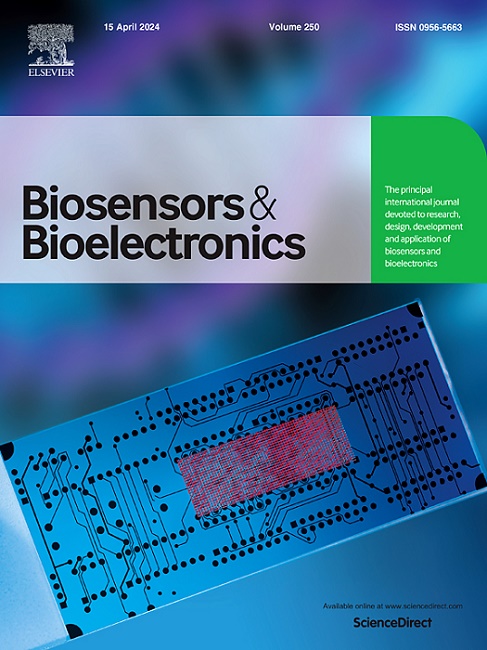纳米通道限制的Ni(OH)2-CeO2复合纳米酶促进鲁米诺-溶解氧的电化学发光,用于免疫传感
IF 10.5
1区 生物学
Q1 BIOPHYSICS
引用次数: 0
摘要
基于纳米通道约束的Ni(OH)2-CeO2复合纳米酶增强鲁米诺-溶解氧(O2)的电化学发光(ECL),建立了一个免疫传感平台,该平台能够灵敏地检测细胞因子。介孔二氧化硅纳米通道阵列膜(SNF)装饰在具有成本效益的ITO电极上,具有超小(2 ~ 3 nm)纳米通道,能够通过连续电沉积工艺限制原位合成Ni(OH)2- ceo2复合纳米酶。Ni(OH)2-CeO2具有双过氧化物酶(POD)和氧化酶(OXD)类酶活性,可作为高效氧还原反应(ORR)催化剂产生活性氧(ROS),催化发光氨氧化。与在平面电极上合成的纳米酶相比,纳米通道限制的纳米酶具有更好的ECL增强。Ni(OH)2和CeO2的结合表现出较强的协同催化性能,在中性条件下,鲁米诺- o2的ECL比无纳米酶约束的电极提高了33.7个数量级。利用肿瘤坏死因子α (TNF-α)作为概念验证,通过在SNF外表面固定识别抗体来制备免疫传感器。TNF-α结合诱导免疫复合物的形成,通过增加界面阻力和阻碍鲁米诺扩散来降低ECL信号。这使得在宽线性范围内(10 fg/mL至10 ng/mL)敏感的TNF-α检测具有8 fg/mL的超低检测限。该免疫传感器具有良好的选择性、稳定性和重复性。本文章由计算机程序翻译,如有差异,请以英文原文为准。
Nanochannel-confined Ni(OH)2-CeO2 composite nanozyme boosts electrochemiluminescence of luminol-dissolved oxygen for immunosensing
An immunosensing platform was developed based on the enhanced electrochemiluminescence (ECL) of luminol-dissolved oxygen (O2) by nanochannel-confined Ni(OH)2-CeO2 composite nanozyme, which is able to sensitively detect cytokine. The mesoporous silica nanochannel array film (SNF), decorated on a cost-effective ITO electrode, features ultrasmall (2∼3 nm) nanochannels, enabling the confinement of in situ synthesized Ni(OH)2-CeO2 composite nanozyme via a continuous electrodeposition process. Ni(OH)2-CeO2 exhibits dual peroxidase (POD) and oxidase (OXD) enzyme-like activities, serving as an efficient oxygen reduction reaction (ORR) catalyst to produce reactive oxygen species (ROS) and catalyze luminol oxidation. Compared to nanozymes synthesized on flat electrodes, nanochannel-confined nanozyme demonstrates superior ECL enhancement. The combination of Ni(OH)2 and CeO2 exhibits strong synergistic catalytic performance, boosting ECL of luminol-O2 under neutral conditions by 33.7 orders compared to electrode without confined nanozyme. Using tumor necrosis factor-alpha (TNF-α) as a proof-of-concept demonstration, immunosensor is fabricated by immobilization recognition antibodies on the SNF outer surface. TNF-α binding induces immunocomplex formation, reducing ECL signal by increasing interfacial resistance and hindering luminol diffuse. This enables sensitive TNF-α detection over a wide linear range (10 fg/mL to 10 ng/mL) with an ultralow detection limit of 8 fg/mL. The immunosensor demonstrates good selectivity, stability, and reproducibility.
求助全文
通过发布文献求助,成功后即可免费获取论文全文。
去求助
来源期刊

Biosensors and Bioelectronics
工程技术-电化学
CiteScore
20.80
自引率
7.10%
发文量
1006
审稿时长
29 days
期刊介绍:
Biosensors & Bioelectronics, along with its open access companion journal Biosensors & Bioelectronics: X, is the leading international publication in the field of biosensors and bioelectronics. It covers research, design, development, and application of biosensors, which are analytical devices incorporating biological materials with physicochemical transducers. These devices, including sensors, DNA chips, electronic noses, and lab-on-a-chip, produce digital signals proportional to specific analytes. Examples include immunosensors and enzyme-based biosensors, applied in various fields such as medicine, environmental monitoring, and food industry. The journal also focuses on molecular and supramolecular structures for enhancing device performance.
 求助内容:
求助内容: 应助结果提醒方式:
应助结果提醒方式:


